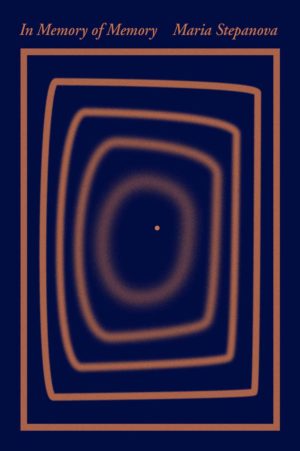In Memory of Memory
by Maria Stepanova, translated by Sasha Dugdale
reviewed by Stephanie Newman
Maria Stepanova’s In Memory of Memory presumes that memory is unrecoverable, flawed, and at times imaginary. Just as memory defies any lasting structure, so does Stepanova’s book resist categorization. The work has been billed as a novel, but its pages contain essays, documents, literary criticism, and hints of historical biography. When In Memory of Memory was published in the original Russian in 2018, it won the Bolshaya Kniga Award for “best prose in Russian,” though Stepanova remains best known internationally as a poet. Sasha Dugdale’s English translation of the text, released by New Directions in February 2021, introduces Stepanova’s prose to an American audience.
The book opens with Stepanova’s middle-aged narrator sorting through her deceased aunt’s belongings in 2010s Moscow. Her aunt’s diaries are filled with minutiae and lack emotion, which disturbs the narrator. She wonders how a diary can provide a “faithful witnessing of the exterior, and a concealment of the authentic and interior,” and this sentiment reminds her of viewing family photo albums as a child with her mother. The objects in her mother’s possession—a century’s worth of postcards, letters, photographs—had fascinated and repulsed the young narrator. Though she had recognized the preciousness of her family archive, she couldn’t create any meaning from its scattered pieces.
In Memory of Memory memorializes the narrator’s attempts to locate such meaning. The form of the novel reflects a sense of fragmentation, as Stepanova explodes the linearity of traditional story. Her narrator embraces the missing links in her family’s history, forgoing the impulse to draw conclusions and instead turning gaps in knowledge into stylistic experiments.
Some of these experiments are more successful than others. The book is at its best when the narrator situates her Russian-Jewish genealogy in a broader historical context. In chapters like “The Jewboy Hides from View,” Stepanova effectively narrates a history of anti-Semitism among Russian literati, as well as self-hatred among Jewish Russian intellectuals. She reads a stash of her great-grandmother’s early twentieth-century postcards, then tries to understand them in light of documents that slur the poet Osip Mandelstam as a “little jewboy” and reveal Boris Pasternak’s desire for Jews to “assimilate, to disappear as a people.” Another chapter, on the Siege of Leningrad, juxtaposes historical records against letters from the narrator’s much older cousin, a Russian soldier who died in the Siege. The cheeriness of the cousin’s notes to his mother stands in uncanny contrast to the terror and starvation during the Siege. As a result, the narrator questions what gets counted as “objective” in historical archives.
Another highlight of the book is Stepanova’s art criticism, which ranges from the photography of Francesca Woodman to the gouache paintings of Charlotte Salomon. One standout chapter looks at the American sculptor Joseph Cornell, whose glass-fronted boxes of ephemera remind the narrator of the Russian game of sekretiki, in which Soviet-era children hid objects of beauty in the ground beneath panes of glass, allowing friends to spot the treasures underfoot. Memory enters into the conversation as the narrator contemplates what humans decide is worth saving.
Yet Stepanova missteps when venturing into the present-day topics of social media, digital photography, and Internet archives. In chapters that diagnose the nature of twenty-first century life, the narrative loses its thread, becomes meandering, and even veers into hyperbole. A paragraph on social media “likes” precipitates the exaggeration that “no one feels unloved in this new world.” Meanwhile, reflecting on digital photo storage, Stepanova concludes: “Nothing is seen as a linear sequence unrolling in time.”The laziness of these “no one’s” and “nothings” undermines the poetic and incisive critical voice that appears elsewhere in the book, ready to stun with phrases like “the scar tissue of oblivion” and “the past … cleaves itself to the present, burrows under its skin, leaving its spores there.”
Still, readers might observe that the many “Things Not Known,” as Stepanova titles a later chapter, have eaten away like moths at the book’s narrative fabric, leaving holes at its center. At once, this is the point of the book and its pitfall. Unfinished narratives and truncated histories are loyal to reality, but they also make for a frustrating reading experience. Sections of the book that lack context, such as the chapter “A Handful of Photographs,” which merely describes a list of pictures, feel less innovative than underbaked.
In Memory of Memory might have succeeded formally as a collection of essays. But a novel, even a genre-bending one, promises its readers a story—and on this promise, In Memory of Memory doesn’t quite deliver.
Published on May 14, 2021

